Proof Of Afterlife By Awareness
Theorem: During life, we experience the entire expanse of our environment. Of the expanse, we are actually focus of very little. These overlooked fragments make up an untapped potential that gets realized at the close of life's journey.
Afterlife Awareness Theorem
1. Defining Human Conscious Awareness
1.1. What Is Human Conscious Awareness?
Conscious awareness is the state of being fully aware of and able to actively perceive, experience, and reflect on one's thoughts, feelings, surroundings, and actions. It involves the capacity to be aware of both external stimuli (such as sensory input from the environment) and internal states (such as emotions, thoughts, or memories). Conscious awareness allows individuals to process information, make intentional decisions, and engage in self-reflection, all while maintaining an active understanding of their existence and the world in which they live. It is the experience of being present and awake, with the ability to direct attention and engage with the external world as well as one's inner mental and emotional landscape.
Being consciously aware refers to the state of actively perceiving and reflecting upon one's surroundings, thoughts, and experiences in the present moment. It involves being fully attentive to what is happening around you, as well as the internal processes such as emotions, sensations, and thoughts. Conscious awareness allows a person to recognize and interpret stimuli from the environment, make decisions, and understand their own mental and emotional states.
1.2. Conscious Awareness as a Single Geometric Point
When we describe conscious awareness as a single geometric point, we are emphasizing the idea of a focused, concentrated center of experience. In geometry, a point is defined as a location in space with no dimensions - neither length, width, depth, or duration. It is a precise position within space and time. [Postulate 3]
Focus and Precision
Just as a geometric point represents a specific, fixed location in spacetime, conscious awareness as a point is about a concentrated focus. At any given moment, our awareness is drawn to a single point of experience - whether it's a thought, an emotion, or a sensory input. In this sense, conscious awareness is like a pinpoint of attention, sharply focusing on one specific aspect of reality at a time. It allows us to engage deeply with a particular element of our experience, while we exclude other stimuli, relegating them in our mind to the background as distractions.
Non-Dimensionality
In geometry, a point has no size or shape - it is purely positional. Similarly, conscious awareness, when conceptualized as a geometric point, suggests that at the core of awareness, there is no size or substance, just the present moment's precise focus. It is not the entirety of our experience, but a condensed, singular aspect within the current environment where all our attention is focused. This singularity highlights the idea that our awareness operates from one "point" of perception at a time, focusing in on specific stimuli without expanding beyond that specific focus.
Momentary and Fleeting
A geometric point exists in a moment, without duration. Similarly, conscious awareness, when seen as a point, is momentary - existing in the now. It does not stretch out in time or space. It is a snapshot of immediate experience. The awareness of a thought, sensation, or perception exists only as long as attention remains focused on it. Once the attention shifts, the point of awareness moves, leaving behind the previous focus.
The Center of Experience
In a geometric sense, the point is where coordinates meet - the center of a particular space. In terms of conscious awareness, this "point" can be seen as the center of one's experience. At any given moment, all of reality for the individual exists from the perspective of this focused point of awareness. The point represents a specific place in consciousness where perception and understanding meet.
Describing conscious awareness as a single geometric point offers a way to understand the nature of attention and experience. Like a point in space, conscious awareness is finite, focused, and momentary, existing only in the present moment with the potential to shift and change. This conceptualization highlights the limitations of human awareness, emphasizing the importance of the here and now. Awareness has the capacity for movement. In this sense, conscious awareness, as a geometric point, is both a precise and dynamic experience, constantly shaping and reshaping the way we perceive and interact with the world around us.
1.3. Watching Awareness Move Through Time and Space
To see how awareness moves through time and space, consider the following thought experiment. Let's say you are sitting at your desk at work. It is 10:00 in the morning. As you are sitting in your cubical a friend walks by and says Hi. You look up and smile. A minute later a bird flies past your window. You catch a glimpse of it as it passes. Then your phone rings. As you reach over to pick up the phone you inadvertently knock your cup of coffee over on your desk, spilling coffee all over your papers. When you draw this up on a timeline of these four experiences, it looks like this:
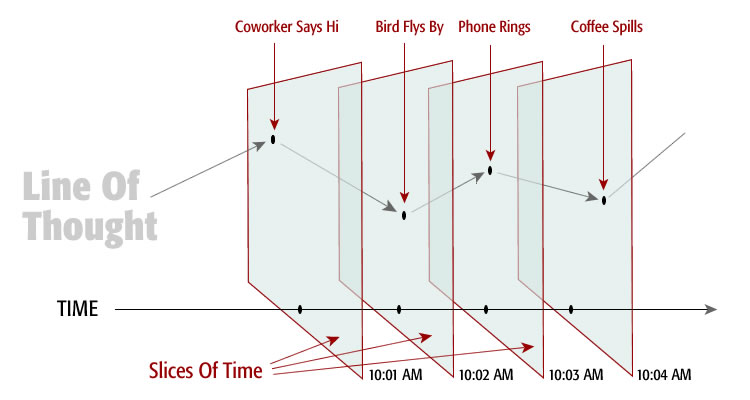
Diagram of how conscious focus can shift within the environment over time, giving the impression it is larger than it actually is (Afterlife Theory).
The period from 10:00 to 10:04 was rather hectic. Looking back on it we tend to think that everything happened at once. In our minds, we think that we got hit with four things at once. However, when you draw it out on a timeline you can see that four things did not happen at once. They happened sequentially over time:
1. At 10:00 you are sitting at your desk. Someone walks by and says hi. Your attention (shown as a black dot) shifts from whatever you are doing to the person.
2. At 10:01 when the bird flies by your attention shifts from the person to the bird outside.
3. Then your attention it shifts again. This time the phone rings.
4. Finally, it shifts again to the spilled coffee on the desk.
At any one time, there is just one thing we pay attention to. Hence, our awareness behaves as a focal point within the environment, much like a single geometric point. This is shown above as the black dot above, shifting focus within the environment over time. It darts from one stimulus to another continuously over time. We tend to focus exclusively on the one thing we deem most important to us at the moment. Then focus shifts as our attention gets preempted by something even more important. In review, we think we have paid attention to all four stimuli simultaneously. Upon closer inspection, we really only focused on just one thing at a time.
2. Awareness and the Party Analogy
2.1. How Awareness Acts in a Social Setting
To illustrate how awareness works in the environment, imagine yourself at a party. Here is my diagram of what the party might look like:
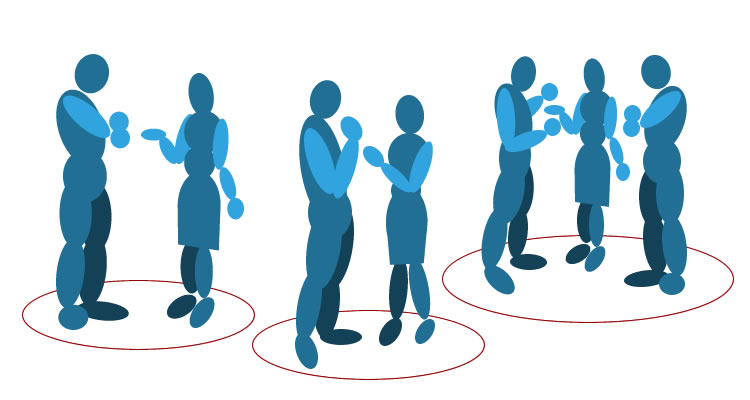
Diagram of party where participants are organized into three groups. The conversational focus is on a single group, rather than all three. This shows awareness is singular in nature.
Imagine twenty people in a fairly small room like this. People are formed into small groups as shown above. Inside each group is a conversation as represented by the red circle surrounding each group. People are standing around, affiliated with their group, listening and commenting on the current conversational topic of their group. Each group maintains its unique line of thought.
We walk around the party alone, not affiliated with any particular group. When we join a group, our awareness focuses in on the conversation of that group. We listen to the conversation of our group, focus on it exclusively, and tune out all the other conversations going on simultaneously in the other groups around the room.
2.2. What We Notice vs. What We Overlook in Our Environment
A diagram of the party from above looks like this. Here is how the party is represented in the diagram:
1. The blue dots represent the people at the party.
2. The red circles represent the conversations of the various groups of people at the party.
3. The lighter green circles represent the range of the sound (noise) generated by the conversations of the groups.
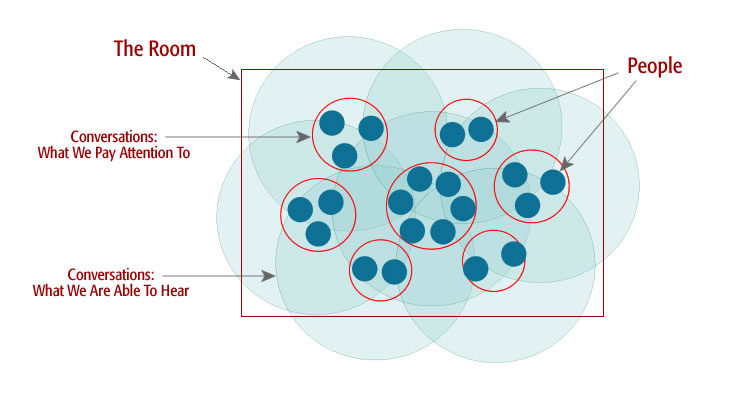
This image shows the party from above. The people are blue dots. The conversations are red circles. The larger blue circles represent the volume travel of the conversion (reach).
When we join a group (shown as a blue dot within a red circle) we listen to the conversation of our group. However, the sound of our group's conversion (as represented by the shaded green circle) extends physically beyond our group. The sound of conversation (light green circle) is much larger than the size of our group (red circle).
Our ability to listen to the conversation in our group (and tune out all the other conversations in the room) is not based on proximity. Nor is it based on sound volume. The conversation we pay attention to is based on awareness. We are aware of (tuned in to) the conversation in our group because we choose to focus on that conversation. At the same time, we choose NOT to be aware of (ignore) all other conversations. Other conversations become background noise. We tune them out. Of all the conversations in the room, we listen to exclusively to one - our immediate group's conversation.
The other conversations are relegated to background noise. They may be just as loud as the conversation we are listening to, but we choose not to listen. We can hear other conversations (as shown by the overlapping green circles) but we do not listen to them. At some spots in the room, we hear three or more conversations. Yet we choose to listen to the one we are in. Our conscious awareness focuses on one conversation only, usually the group we are standing in.
We could, if we wanted to, tune out (ignore) our group's conversion and tune into a conversation elsewhere in the room. There is nothing to stop us from doing this. Our attention shift happens all the time. All we have to do is shift our awareness from our group to another group and follow their line of thought. We do not need to move physically. All we need to do is change our focus of awareness. When our awareness focuses in on another group's conversation, we will lose the line of thought in our own group's conversation. While your attention is with the other group, our group's conversation gets relegated to background noise.
2.3. Shifting Focus: Awareness Changes in Space
A change in conversational focus happens like this. The woman in the back right of the room is interested in what the man on the far left has to say. To hear his conversation, she stops paying attention to the conversation of her immediate group and focuses her attention on the man's group across the room. Now she listens to their conversation. She has tuned out both her conversation and the conversation in the middle of the room as shown here:

This Diagram shows how a person in one group can shift focus and listen to a conversation in a neighbor's group. It shows focus is based on intent, not proximity or volume.
She can shift from hearing her group's conversation and listen to his conversation this because awareness is based on attention, not proximity or volume. While a shift in focus like this is possible, ignoring the people in your group is not good manners. So as soon as someone in her group speaks to her directly and grabs her attention, her focus will quickly shift back to her group and pick up the thread of the conversation where she left off.
It is important to realize that her focus can be in her group or it can be across the room but it cannot be in both places simultaneously. We can simulate having focus in two places at once by darting back and forth between conversations. Shifting focus between stimuli like this is like the worker, bird, phone, and coffee analogy in section 1.4 above. What appears to be awareness in two places simultaneously is actually two acts that happened over time. Our attention may dart between conversations quickly, but at any one moment our awareness is focused on just one conversation.
2.4. Changing Awareness Relies on Intention, Not Proximity or Volume
Intention of focus is a fundamental concept of awareness. If we consider the party room as a whole, with all its groups and conversations, we focus on only the conversation we are interested in. We "tune out" all the other conversations that we are not interested in. The conversation we are interested in is but a small subset of all conversations going on in the room. We can show the relationship between the one conversation we focused on versus all the conversations like this:
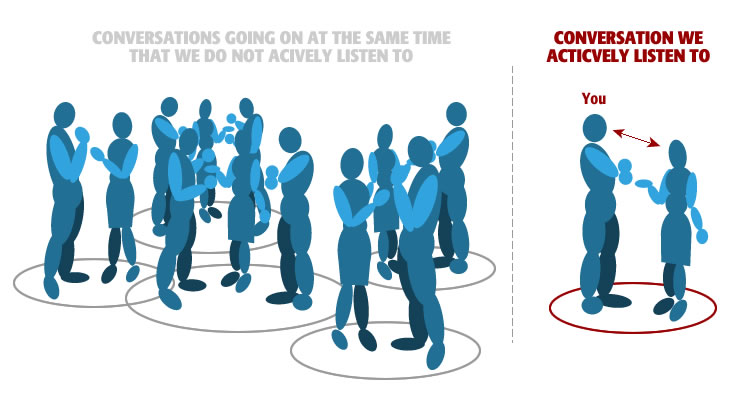
Diagram of the state on consciousness in a party setting. There are many conversations in the room, although we only actively listen to one. All others are in the background.
The left side of the diagram shows all the conversations going on in the room. These are loud enough to hear but we have chosen to ignore them. The right side of the diagram shows the one conversation we are paying attention to currently. There is a one conversation we actively listen to. There are also many conversions in the room that are loud enough to here but have chosen to ignore.
The important thing to realize is we have multiple conversations going on at the same time. One we are actively listening to. The others we are not. However, all conversations are part of the environment. In other words, we listen to one but our ears hear both. All conversations come in through our senses. Yet only one gets focused attention. Does this mean the background, non-listened-to conversations are less important? Or does it mean they don't exist? All conversations are equally important because they are all loud enough to hear. They are all part of the same environment. Throughout life, we take in stimulus, like the un-listened to conversation, without even being aware of it. Does this mean that what we are only aware of a small portion of our overall environment?
3. The Relationship Between Awareness and Spacetime
3.1. Visualizing Conversations as Arrows
The conversations in the room are represented as arrows coming at us as shown below. The arrows are the incoming stimulus hitting our ears competing for our attention. Of all these conversations, one conversation has our attention. It is the conversation shown in red. This is the one conversation we are actively listening to. It is the one we currently aware of. The other conversations are relegated to the background. We consider them background noise. While we hear them, we do not pay attention to them. Hence, they do not get our attention. Visually awareness looks like this:

This is an abstract view of the conversions in the room. The conversations are shown as arrows. All the conversations are loud enough to reach your senses. However, only one conversation, shown in read, is actually being heard.
So here is what we have:
1. On the left side, we have the total environment represented by all the conversations in the room.
2. On the right side, we have the one conversation we are currently engaged in and listening to.
In conclusion, we are not aware of all the conversations around us at any one time. The sequential nature of awareness (darting about the environment over time) leads us to believe we are aware of more conversations than we are. As the party analogy shows, at any one moment in time, we are aware of just one conversation. This is but a small portion of all the conversations we hear.
3.2. Awareness Versus Space
At the party we are listening to one conversation while 12 other conversations are going on at the same time. Those ignored conversations are considered background noise.
The illustration below shows the conversations in the room as arrows approaching our consciousness. The heavy black vertical line represents the current moment. The black line represents conversations that are being taken in through our ears. We hear all of them. We know we hear them because all we need to do is stop a moment, change our focus to any one of them, and we will be able to listen to the conversational thread. Their sound is reaching our eardrums.
Of all these conversations, we focus on just one. That is the conversation shown in red. That is the one conversation able to get through to our conscious. It alone has our attention. All others are tuned out. We hear them, but we don't listen to them. Visually that looks like this:
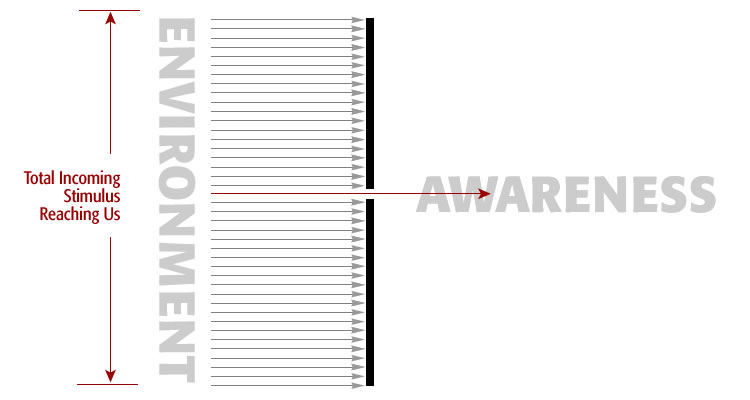
This illustration shows all the stimuli in the room. It shows the conversations, as well as the walls, lights, carpet, noise, and other sensory input. Even with this increase in sensory input, only the one actual conversation is being listened to (getting through to awareness).
When represented as a diagram like this, it becomes clear there is much more going on in the environment than we are aware of. We actively listen to one conversational thread. Meanwhile, the other conversational threads that are hitting our eardrums are relegated to the background.
Whether we listen to conversation A or conversation B, is a matter of choice. It points out that there is more going on in the environment than we are aware of. This becomes clear when you look at one moment in time. The next step is to examine the ratio between awareness and the environment. Awareness is less than the environment, that much we know. How much less needs to be determined. Are we aware of half our environment? Are we aware of one-quarter of our environment? What is the mathematical relationship between our awareness and our environment?
3.3. Awareness Versus Time
Thus far, the thought experiments with awareness have taken place at one moment in time. We are now going to examine awareness over time. The red arrow below shows the moment we are in now. We can call it noon. This is the present moment. The moments shown in gray are the moments in the past. These are moments you just experienced. You were in them a moment ago. As shown in the diagram below, only the present moment can garner awareness. The moments of the past are blocked from awareness as shown here:
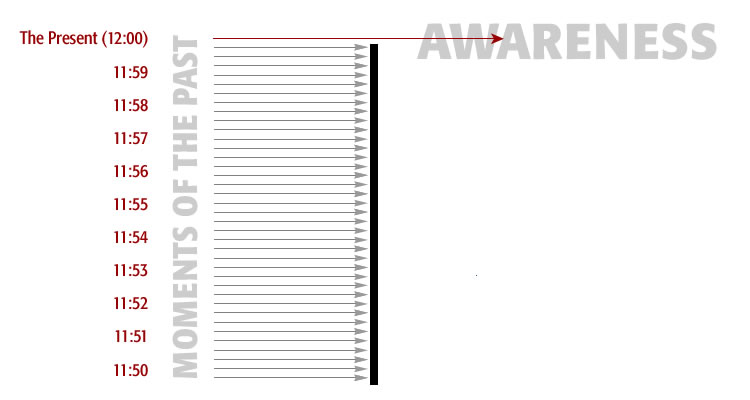
This illustration shows that awareness is only 'aware' of one moment in time, that being the present moment. All other moments of the past still exist in memory, but consciousness is not aware of them.
Awareness operates in time exactly like it operates in the environment. In the environment, we are aware of one conversation at a time. In time, we are aware of one moment. We are aware of the present only. Awareness is located in the present moment. The present is only one point in time.
3.4. Conclusion: Awareness is a Small Subset of our Total Space Time
Our awareness is limited to a small subset of the vast and complex environment that surrounds us. Although our senses are designed to detect and process information from our world, our brains filter most of this input, allowing only the most relevant stimuli to reach conscious awareness. This means that much of the richness and intricacy of the world goes unnoticed.
Our brains focus on specific elements that are deemed significant, such as a friend's voice in a crowded room or the sight of an approaching car while crossing the street. Meanwhile, less immediately important details, like the murmur of distant conversations, fade into the background. This filtering process is selective, leaving out countless aspects of our environment.
Much of the environment's stilulus on us is unconscious. Our brains rely on mental shortcuts and assumptions to construct a simplified model of reality, often filling in overlooking details that don't fit our expectations. This cognitive efficiency helps us navigate the world but also creates blind spots in our perception. Ultimately, our awareness is like a flashlight in a dark room, illuminating only a small portion of the total environment while the rest remains in shadow. Recognizing this inspires us to appreciate the unseen stimuli of our surroundings. We will explore that in the next section.
4. The Theorectical Opening of Awareness
4.1. Theoretical Opening of Awareness in Space
Adding two additional points of awareness changes the ratio of awareness versus the surrounding environment. With two additional cameras, we have theoretically opened awareness within the environment. Until now we have been aware of just one conversation in the room, like a single camera. In the illustration below, we open awareness so now we are aware of three conversations, by adding two more cameras. That looks like this:
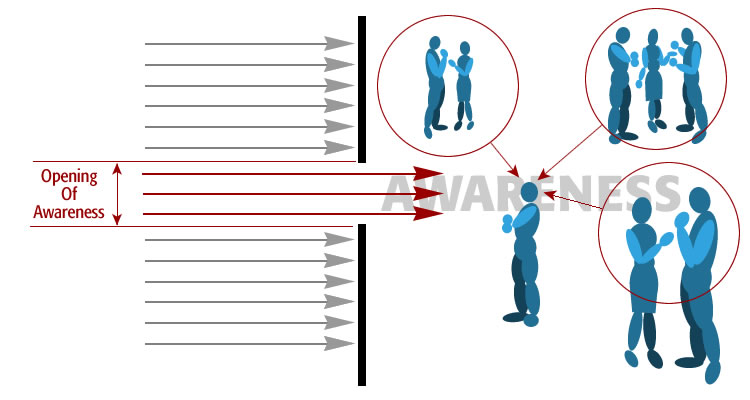
This illustration shows a theoretical opening of awareness to include three separate conversations at once. This is analogous to being aware of three conversations at once, resulting in incomprehensible confusion.
The illustration shows three conversations getting through to awareness simultaneously, instead of just one. Three simultaneous conversations are shown as three arrows in red on the left. Normally just one conversation gets through. We listen to just one at a time. Now, instead of listening to one conversation, we are actively listening to three as shown by the groups on the right.
What would it feel like to listen to three conversations at one time? We have no frame of reference for this because this never happens. However, we can speculate based on a few assumptions:
1. You can eliminate any jumping back and forth between groups because this takes place over time. We are talking about a single moment in time.
2. Each conversation would be attacking our conscious mind with the same interest and focus as we previously had with just one. Rather than listening to one and hearing three, we are talking about listening actively to all three simultaneously.
3. If asked to take an exam on the subject matter of each conversational thread we could pass it.
The result of listening to three conversations would be complicated, chaotic, and confusing. It would be as though three different groups were shouting at you demanding to be heard exclusively. Without the ability to hold back the other two conversations, we would descend into madness within minutes.
4.2. Theoretical Opening of Awareness in Time
We are now going to theoretically open awareness to three moments. This works exactly like opening awareness to three conversations simultaneously. Instead of just being aware of the present moment, we are now aware of the present and two additional moments from the recent past. This is what that looks like:
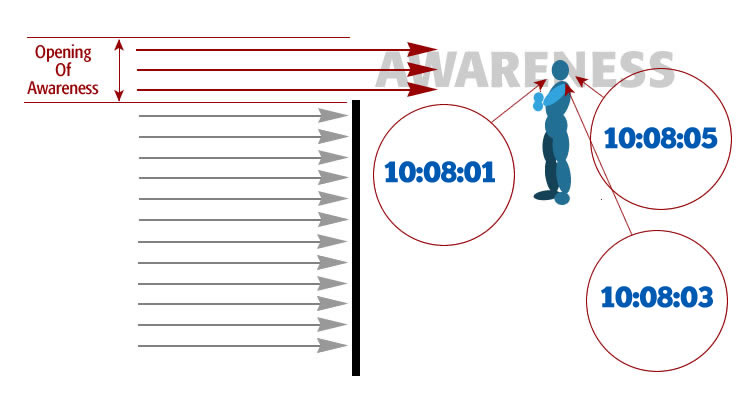
This illustration shows awareness of three distinct moments in time, instead of just one. In this view, the three separate moments are 'getting through' to awareness. This shows that awareness is present in all three moments at once.
4.3. Simultaneous Awareness Over Three Moments
The illustration below shows awareness in time. Here are three moments in time. We are in the first moment at 10:08:01. Then two Seconds pass. Now we are in the second moment at 10:08:03. Then two more Seconds pass. Now we are in the third moment at 10:08:05. We experience each moment as it happens. Awareness is located at that moment. Then time passes and awareness moves with it, as you move into a new moment.
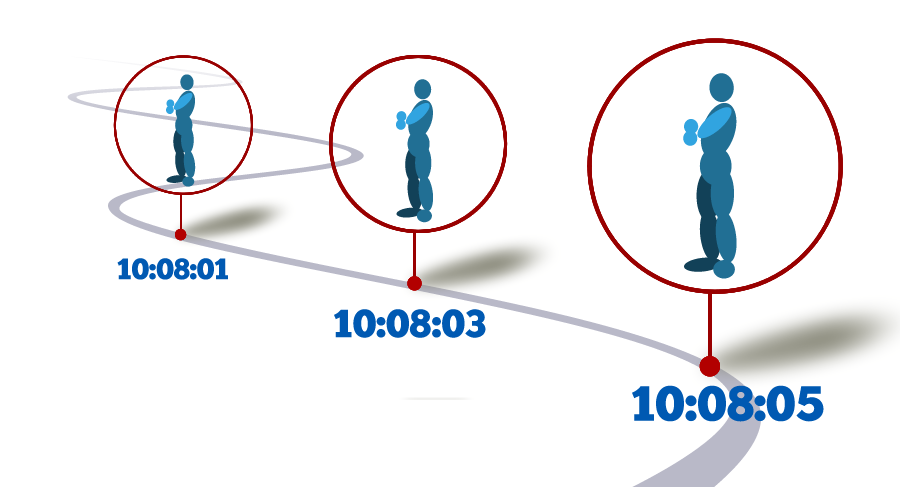
This illustration shows awareness located in three locations in time. During life, we are confined to just one moment - the present. In this theoretical experiment, we show awareness being in all three moments.
Normally we are only aware of the moment we are in. When we open awareness to include two additional moments of the past the environment changes. Remembering a moment and being in a moment are two different things. Opening awareness is being in three moments at once. Next, we take a look at what it would be like to be in three moments at one time.
4.4. What It Looks Like to Be Aware of Multiple Moments
What would it feel like to experience three moments in time simultaneously? It would be unimaginably confusing, as shown below. This is what it would look like when you pass your hand before your face. This is experiencing multiple moments at once as shown here:

This illustration shows what would happen if awareness were allowed to be resident in multiple moments at once. You can see how quickly the environment gets complicated when awareness is not confined to the present.
How confusing would it be to experience in five moments at once? When you move your hand, you wouldn't see one hand, you would see five as shown above. Experiencing five moments at once would cause the single hand would be fanned out in a matrix of five hands. From this perspective, you could not possibly know which of the five hands was the real hand. How could you hold onto anything? Furthermore, it would not be just the hand with this difficulty. It would be the entire environment.
Experiencing more than one moment would plunge us into utter chaos. Every moment would be demanding your full attention. You could not tell what is present and what is past. The result of living in multiple moments would be realities superimposed on each other with each demanding the importance of the current reality. You would be drowning in confusion.
5. Demonstrating Awareness Expansion Using 3D Software
5.1. Simulating Awareness in Space
Three-dimensional software provides an excellent analogy of awareness and environment. The diagram below shows a large cube surrounding a red ball. If you can get this one concept, you will be well on your way to understanding the afterlife. Here is how to envision this:
1. The blue cube represents the environment. Given that we are using two-dimensional art, some imagination is required. Imagine that you expand the cube. In your mind, make the cube larger. Increase the cube in size until it completely engulfs your surroundings.
2. Now do the opposite with the red ball at the center. Decrease its size. Make it smaller and smaller until it is a single point.
This represents an accurate model of awareness and the environment. The environment is the blue cube at infinite size. Awareness is the red ball, reduced to a single point. This is how awareness works during life.
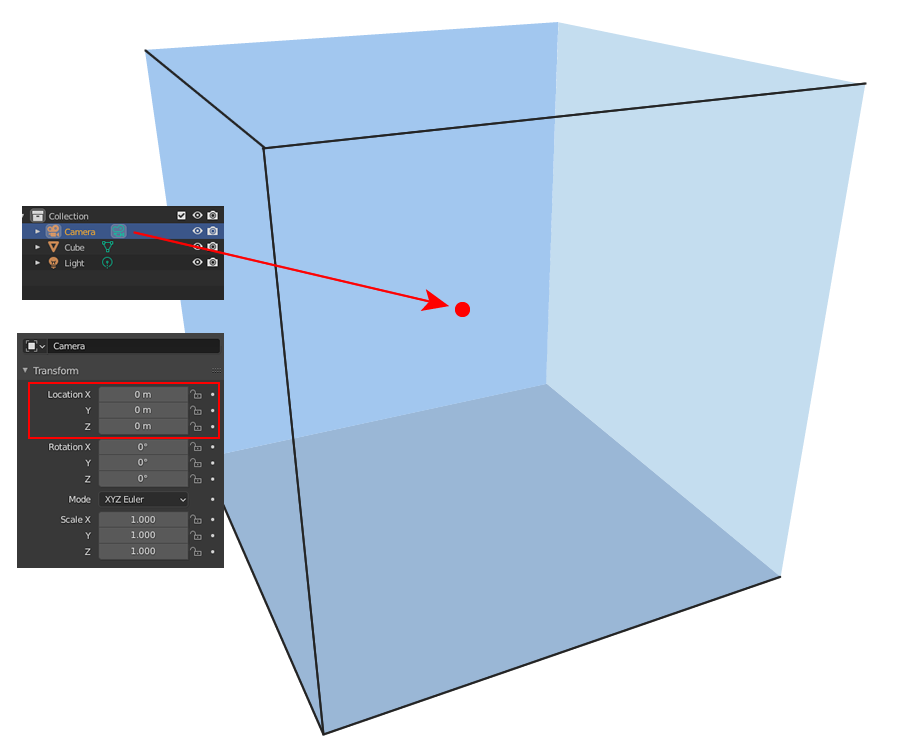
This illustration shows the awareness point of view within the environment. It also shows the 3D controls that indicate that the camera (awareness) is located at a single point with an X,Y,Z location within 3D space.
Awareness in life operates like a camera in three-dimensional software. The camera is the point of view from where we view the environment. Notice in the diagram above, I have included the coordinates of the camera represented by the red ball. The camera is located at 0 in X, 0 in Y, and 0 in Z. The camera, or point of view, is located at the exact center of the environment. This is an accurate awareness-environment model as we go through life.
5.2. Theoretically Expanding Awareness in Space
The question now becomes, how can we triple our awareness within the environment? The answer is, that we are going to add two more cameras as shown below.
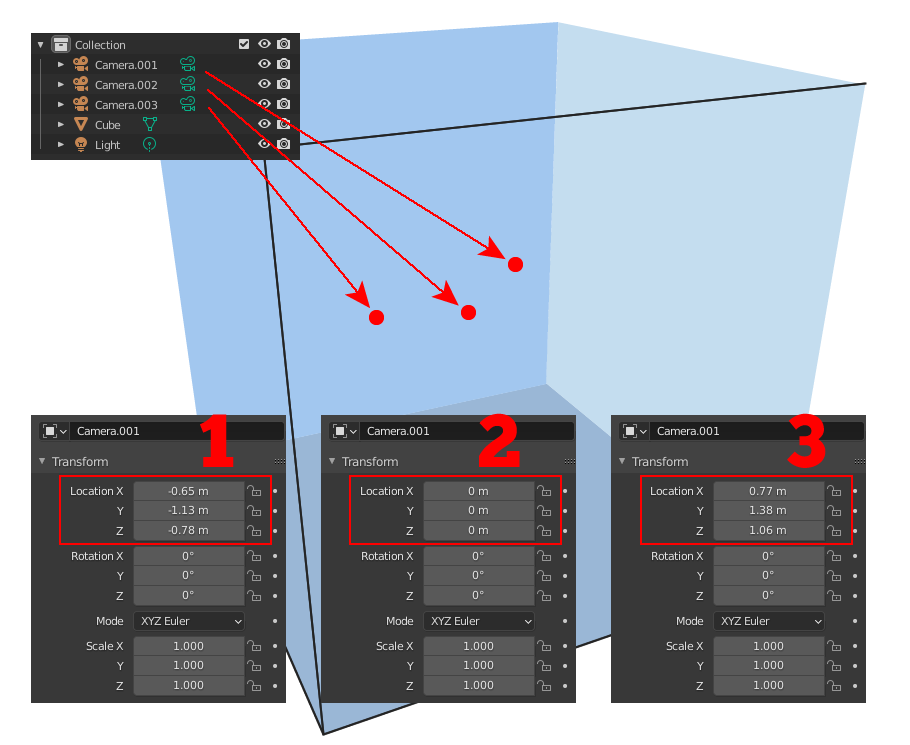
This illustration is an actual model of opened awareness in 3D space. Normal awareness is one camera in the environment. Opened awareness is three cameras in the environment. Adding more active cameras opens awareness from a single point of view to three.
Now we have added three cameras to the environment. You could say we have tripled awareness by adding two more cameras, however, there is a limitation within the software that prevents this. The three-dimensional software is designed so there can only be one active camera at a time. Although we have three cameras in the environment, only one of them is active. This means that we still have only one point of awareness within the space of the environment.
However, what if we were able to modify the software to allow more than one camera to be active at a time? The output of each camera would be fed into the viewport simultaneously. Normally we have one camera fed into one viewport. Now we have three cameras fed into one viewport.
5.3. Experiencing Multiple Cameras Simultaneously
As the second and third cameras become active, the environment becomes more complicated. You would now have shapes and images from three cameras being fed into a single awareness. The result would be three times the objects superimposed and intermingled within the environment. Three-dimensional software can only have one active camera so this never happens. The human experience only has one active camera so this never happens during life either. However, in theory, it could happen. When it does, multiple cameras are feeding input into a single viewport. The situation in the viewport becomes hopelessly complicated.
We now have three active cameras but only one viewport. You can think of the viewport as the ability to understand what the camera is putting out. When output from the cameras becomes more than the viewport can understand, confusion ensues. The viewport simply does not have the awareness capacity to understand the abnormally high level of stimulus from three cameras.
To rectify the situation, we need to increase the ability to understand the incoming stimulus. We do this by adding viewports. When you go from one to three viewports, the environment goes from complicated to trivial. It does this because we have increased awareness from one point to three. The size of awareness has increased threefold. Consequently, its ability to comprehend data has increased as well. Increasing awareness is mind-expanding. It takes understanding the environment from a state of being complicated to trivial. This is not because the amount of stimulus has decreased. This is because the capacity to be aware of the environment has increased. Next, we will examine what happens when we increase the size of awareness to its maximum potential.
5.4. Theoretically Expanding Awareness in Time
The theoretical question becomes, how can we triple our awareness in time so we can experience all three moments at the same time? We can illustrate the answer to that question using three-dimensional software as shown below.

3D software is intended to show just one moment in time as the present moment, just like life. We could, however, add two more pointers and the system would now show three present moments, superimposed onto each other into one complicated reality.
The normal human condition is shown as environment number one above. The time is 10:08:01 as shown on the clock. The corresponding pointer on the timeline above is set at 10. Normally three-dimensional software only has one pointer. That is a requirement. The pointer location indicates the moment we are in. We can change that moment by sliding the time pointer to a new location. When we do, the environment changes accordingly.
To triple the amount of awareness in time, we would need to add two more pointers as shown here. The result would be three-time pointers instead of just one. This would cause the environments from three different time locations to be fed into the viewpoint simultaneously. The result would be complicated as three environments would be fed into the present moment.
5.5. Experiencing Multiple Moments Simultaneously
We know by looking at the illustration above that we could not possibly cope with experiencing multiple moments at once. When we opened awareness from one moment to five, we unleashed all kinds of confusion. This is because we haven't increased the size of awareness. In the analogy of three-dimensional software, we have taken several environments and fed them through one viewport. Thus, they are superimposed and confusing. To increase the size of awareness, we would need to take five environments and feed them into five viewports. Hence, we have gone from a situation where things were complicated and made it into a situation where things are trivial. The amount of environmental stimulus has not changed, but the ability to handle that stimulus has. Increasing the size of awareness increases the ability to handle stimuli. Increasing the size of awareness causes things within the environment to go from complicated to trivial.
6. Finding the Upper Limits of Awareness
6.1. Determining the Limit of Awareness Within Space
In the thought experiment above we opened our awareness from one point to three. Imagine opening awareness from three points to six. Now we have six arrows in red. Imagine opening awareness up still further. Imagine being able to open up and fully understand every conversion in the room all at once. Continuing this trend, imagine opening awareness up still further and pushing it to its upper limit. The next step is to solve for the upper limit of awareness within space. We are trying to find the geometric relationship between awareness and the surrounding environment. Expressed as an equation it looks like this:
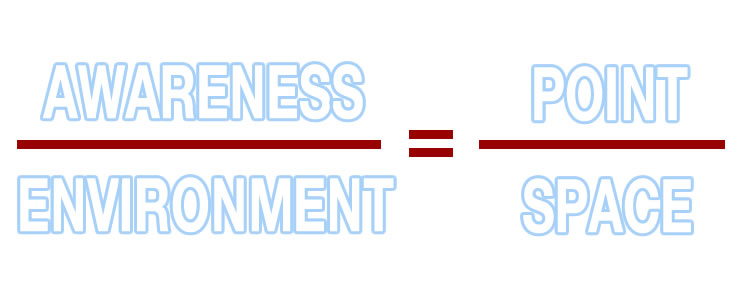
This illustration shows what happens when awareness opens all the way up. The upper limit of awareness is the environment. This relationship, between awareness and its environment, is one of point (0D) to space (3D).
The left side of the equation shows the relationship between awareness and the environment. During life, awareness is a point of view within its environment.
The right side of the equation shows the geometric equivalents. On top, we have a point. This is analogous to conscious awareness. On the bottom we have space. This is analogous to the surrounding environment. The relationship between point of view (awareness) and the environment is the same as their geometric equivalents, a point within space versus its surrounding space.
On the top (the numerator) we have what awareness is during life. On the bottom of the equation is the upper limit of awareness (the denominator). This represents what awareness could eventually become. The upper limit of awareness is its surrounding environment.
6.2. Determining the Maximum Limit of Awareness Over Time
What is the upper limit of the size of awareness within time? During life, we have one point of awareness in time per environment. In our thought experiment, we have increased the size of awareness from one point in time to three, essentially tripling the size of awareness.
With the size of awareness tripled, we have three active moments. The remaining moments of our lifetime are inactive. If we expand awareness where 10 moments are active, we have the remaining moments of a lifetime that are inactive. If we expand awareness in time further, we will eventually reach the upper limit of time. The upper limit of awareness in time is an eternity. This is all time relative to an individual. It is all moments from the beginning of life to the end of life. Expressed as an equation, the ratio between awareness and time looks like this:

The equation shows the relationship between the present moment and a lifetime with respect to time. That relationship, in terms of time, is a single moment to an eternity. An eternity is every moment ever experienced.
On the left side of the equation we have the ratio between awareness and life. Awareness, during life, is in the present. The upper limit of awareness is a lifetime, from conception to now.
On the right side of the equation are their geometric equivalents. On top, we have a moment, a single point in time. This is analogous to the present. On the bottom, we have an eternity. An eternity is all time. The relationship between the present (awareness) and a lifetime is the same as their geometrical equivalents, a moment in time versus an eternity.
On top of the equation (the numerator) is what awareness is during life. On the bottom of the equation is the upper limits of awareness (the denominator). This represents what awareness could potentially become.
6.3. Unlocking Our Untapped Information Potential
You're sitting in a room surrounded by five conversations. You listen to one. You hear the other four. You only paid attention to one. You ignored the other four. You heard all five conversations. They entered your ears and were absorbed into memory. Yet you only paid attention to the one conversation you participated in. The question is, what becomes of the other four conversations?
All five conversations are in memory. One was relevant. It was actively listened to. The others are irrelevant. Yet all were retained in memory. The information that was unnoticed during life far exceeds that which was noticed. Why do we gather unnoticed information? What is the purpose? Could it be that we use unnoticed information to assist in decision-making? Or to keep ourselves safe? Or could unnoticed information have a higher purpose?
Gathering unnoticed information, over a lifetime, represents a huge unrealized potential. We don't know how huge our unrealized potential is because we weren't aware of it in the first place. Everything else during life is retained in memory. Here is a diagram of awareness and memory:

This is a 3D model showing awareness and memory. Awareness is shown as a small box (actually, it is a point), and memory as a large box (actually, it is the surrounding space). When boxes are pushed to their limit, you have a point of awareness surrounded by a space of memory.
The illustration above is a diagram of two boxes. There is a small box and a big box. The inner box represents awareness. The outer box represents memory. The mental image is to make the inner box smaller while making the outer box correspondingly larger. Push the inner box to its smallest possible size. Push the outer box to its largest possible size. When you do this, the inner box becomes a point at the center. The outer box becomes the environment. The inner box is awareness. The outer box is memory.
The human mind is both boxes. The human mind is not just awareness at the center. It is awareness surrounded by memory. During life, we experience a point of awareness. We take in information as we move through life. Meanwhile, in the background and completely unbeknown to us, memory is like a mega-mouth shark. It scoops up the environment in total as it moves through life. Memory absorbs everything. We are the point of awareness surrounded by the space of memory. That is the human condition during life.
6.4. Understanding Awareness Across Space and Time
During life awareness acts like the active camera in three-dimensional software. During life, you can only have one active camera. At the end of life, those restrictions no longer apply. Awareness is unleashed to expand throughout time and space. Awareness expands within memory. This is when our unrealized potential is realized. Awareness changes in dimension from a point to space, thereby expanding throughout space. Awareness also changes dimension from point in time or the present moment, thereby expanding throughout time.
We now know awareness changes dimension at the end of life. Awareness transitions from a point in time and space to all time and space. To see this visually we are going to rotate time back to reveal space in an unconventional four-dimensional view (length, width, depth, and time). The diagram looks like this:
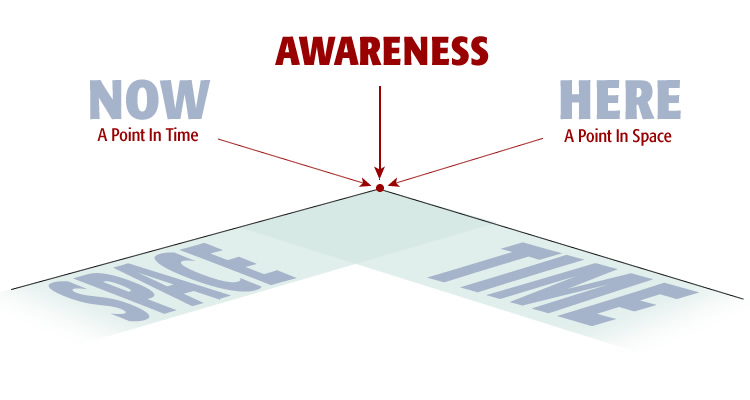
Space-time is a 4D realm that exists within memory. Its exact opposite is a single moment, which is a single point located within space-time. Awareness is a point. Memory is a space. They are opposites and inverses.
This diagram shows awareness as a point in time and space. We can envision awareness being located at a specific point in time, and a specific point in space. Awareness can be thought of as a single point in a time/space continuum.
6.5. Determining the Maximum Limit of Awareness Across Space and Time
This illustration shows the state of awareness before and after the end of life:

This equation illustrates the relationship between awareness during life and awareness in afterlife. During life, awareness is confined to a single point in space-time. In afterlife, awareness is everywhere throughout space-time.
The state of awareness before the end of life, is shown on top. The state of awareness after the end of life is shown at the bottom. The left side of the equation shows awareness on top and memory on the bottom. The right side shows the geometric equivalent. On top is a point of view with time and space. On the bottom is everything - all information from all environments throughout a lifetime, realized and unrealized. On the bottom right we have a time-space continuum of unlimited length, width, depth, and time. This has also been called the kingdom of heaven.
6.6. End of Life: Expanding Awareness Across Space and Time
In the previous section we spoke about the duality of the human mind. On the one hand, we are the focal point at the center of our environment. That is the point. On the other hand, we are the memory of the surrounding environment. The is the space. Our mind is both - the point of awareness contained inside the memory of the environment.
There is also a third mind. We have the little mind, the big mind, and the super big mind. The super big mind is time. It works like this.
As we move through life, we experience moments. In the moment we are the little mind of awareness. We also are the big mind of memory. Both get absorbed into memory.
Hence memory becomes the third mind. We have awareness, contained in the environment. We also have the environment, contained in memory.
In terms of unrealized potential we have awareness represented as a single point in time and space. Then we have the environment, represented as a space within time. Then we have time itself. What we are aware of during life is like a single point of no width, length, depth, or duration. What we are unaware of during life is unlimited width, length, depth, and eternity. It is the smallest possible thing to the largest possible thing. Visually that looks like this:

This illustrates what happens to awareness at the end of life. Awareness transitions from a single 'point/moment' to all of 'space-time'. Memory makes this possible. Awareness changes dimension and becomes the opposite of what it was. It is now its upper limit, which is everything.
During life we are the point in the center of our environment. Awareness is shown as the small red dot in the center of space. Awareness is a
At the moment life ends, awareness explodes throughout time-space. The illustration shows expanding boxes representing awareness expanding outward from its central location. The concentric boxes represent awareness expanding into time-space.
In the drawing, awareness goes from one unit to two units. Then it goes from two units to four. Then it goes from four units to eight. Finally, awareness expands out to its fullest extent absorbing all of time-space.
Understanding the afterlife requires thinking in geometric terms. Geometrically, the end of life is a point in time-space becoming all of time-space. Afterlife is awareness undergoing a dimensional change to become everything.
6.7 Afterlife: One Moment of Infinite Potential
Afterlife is a profound realization of unrealized potential - a moment where awareness transcends its limitations within time and space. During life, awareness operates as a focal point surrounded by space, where all experiences are filed into memory. This memory, all-encompassing and permanent, becomes a reservoir of untapped potential, preserving every thought, emotion, and interaction.
At the moment of death, awareness undergoes a change of dimension. What was once a point of view within space extends to encompass all time and space simultaneously. This shift transforms the final moment of life into an eternal experience, where every memory and experience is fully realized and lived concurrently. From the individual's perspective, this is not a fleeting event but an eternal state of being - a convergence of all moments into a singular, all-encompassing existence.
The process is physically made possible because memory, which retains everything, becomes the medium through which this expansion occurs. At the end of life, we are in the presence of all that we have known, done, or felt. The afterlife, then, is not a continuation in the conventional sense but a fulfillment - a realization of the "kingdom of heaven" contained within memory.
From an external viewpoint, the afterlife is brief, a single moment in time. However, for the individual experiencing it, that moment expands into eternity. It is a transition from being a finite observer within time-space to becoming all of time-space itself. This transformation turns the limitations of life inside out, granting omnipresence. Afterlife aligns with the divine because in death we achieve a state of infinite awareness.
Afterlife, therefore, is a culmination - a point in time that becomes the universe. It represents the ultimate unity of life and memory, transforming life into the infinite and the eternal.
-- This concludes Theory Of Afterlife by Awareness --